On August 12 and 13, 1997 I visited the Upper Geyser Basin and Old Faithful. Got to see the Beehive Geyser go off from a distance - it's a real straight up fire hose of a geyser. Unfortunately its several days before it goes off again.
Saw several geysers go off including Grand (more spectacular than Old Faithful in many respects), Daisy, Castle (from a distance) - and Old Faithful twice (once from a distance and once up close).
Saw the Morning Glory Pool which has lost some of its glory. The road we drove on back in the early 50's is now a walking/bicycling path.
Nathaniel P. Langford, a member of the 1870 Washburn Expedition-who named many of the thermal features of the Upper Geyser Basin, later stated; "We gave such names to those of the geysers which we saw in action as we think will best illustrate their peculiarities." Those names include Old Faithful-named for its regular eruptions over 100 feet; Beehive Geyser-with its bee-hive shaped cone; and Riverside Geyser-named for its location on the Firehole River.
The Upper Geyser Basin, approximately two square miles in area, contains the largest concentration and nearly one-quarter of all of the geysers in the world. A variety of thermal features exist here: spouting geysers, colorful hot springs, and steaming fumaroles.
The Upper Geyser Basin is the home of Old Faithful, the most famous and celebrated geyser in the world.
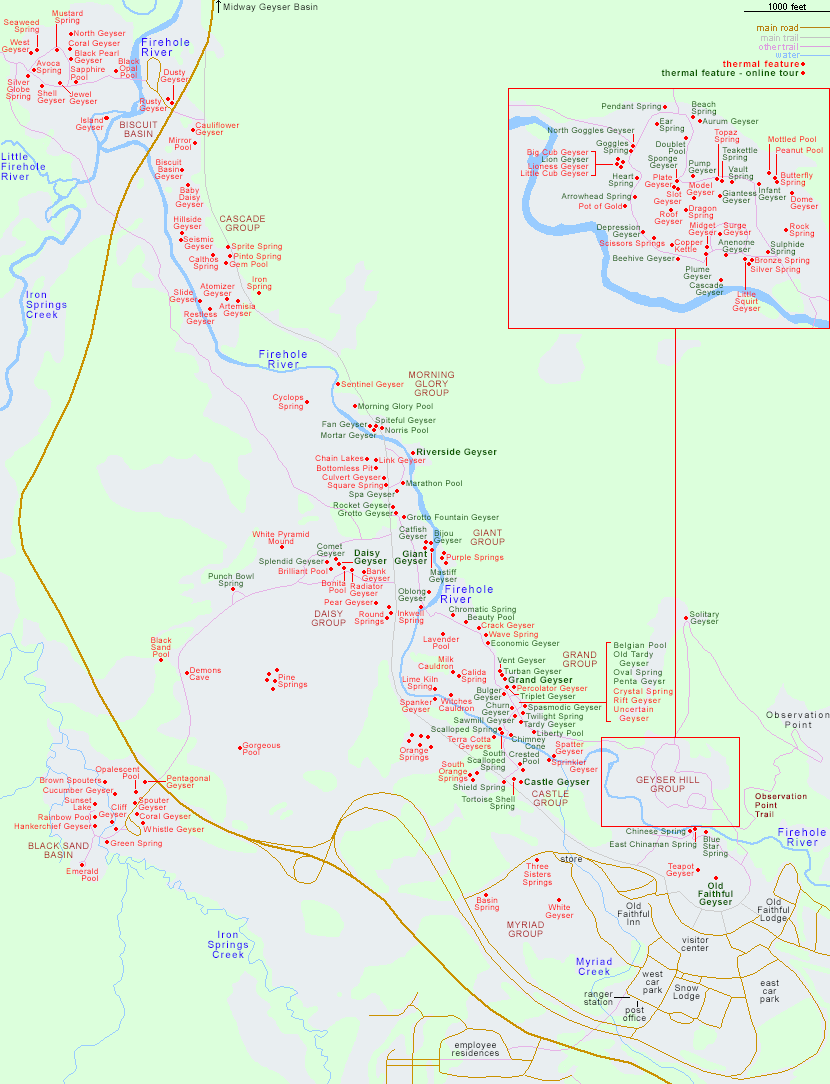
Upper Geyser Basin Video Tour
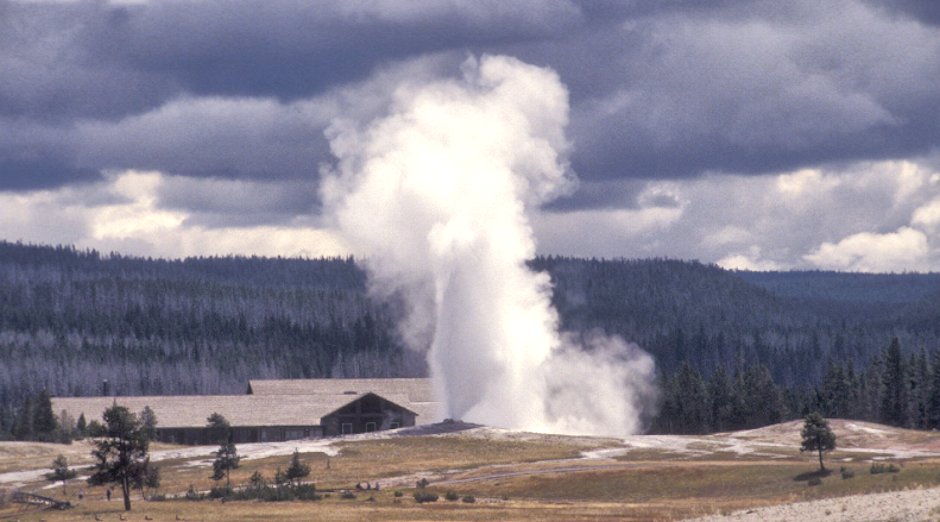
Old Faithfull Geyser, Yellowstone National Park
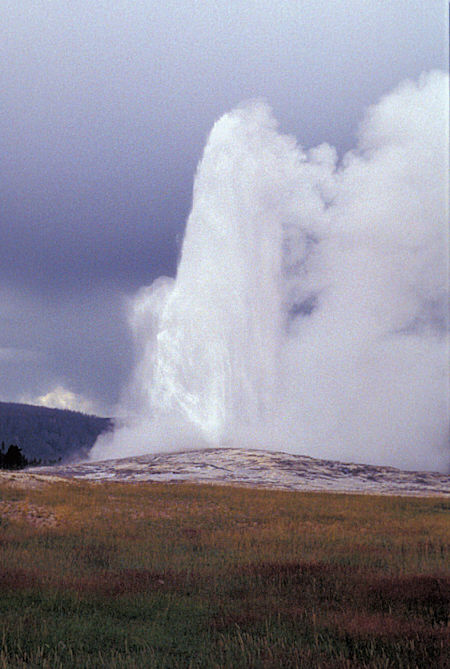
Old Faithful Geyser, Yellowstone National Park
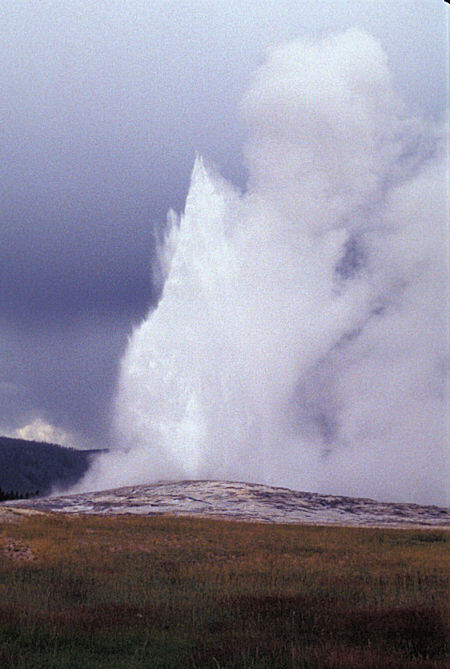
Old Faithfull Geyser, Yellowstone National Park
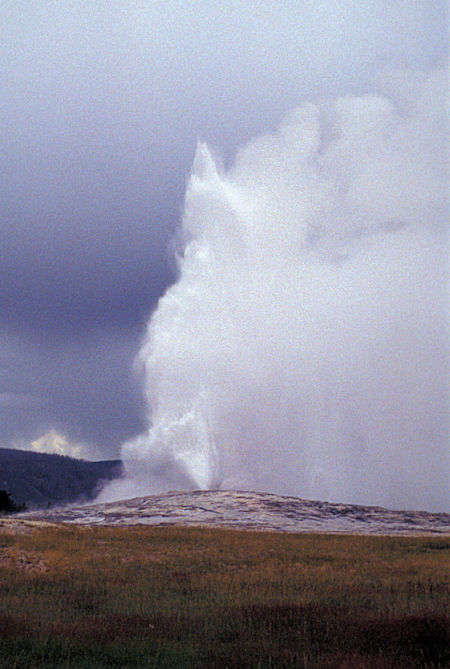
Old Faithfull Geyser, Yellowstone National Park
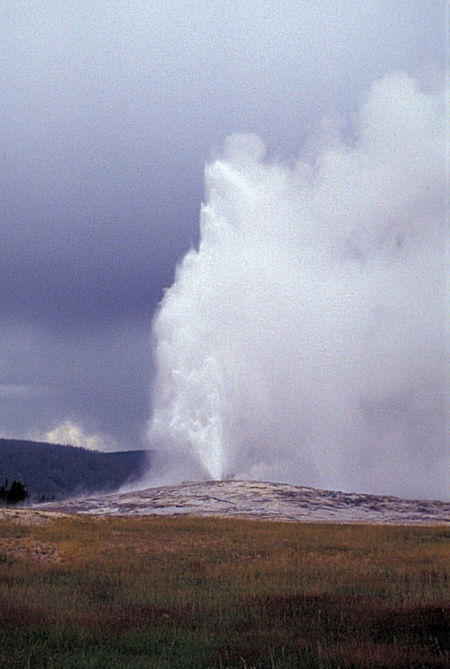
Old Faithfull Geyser, Yellowstone National Park
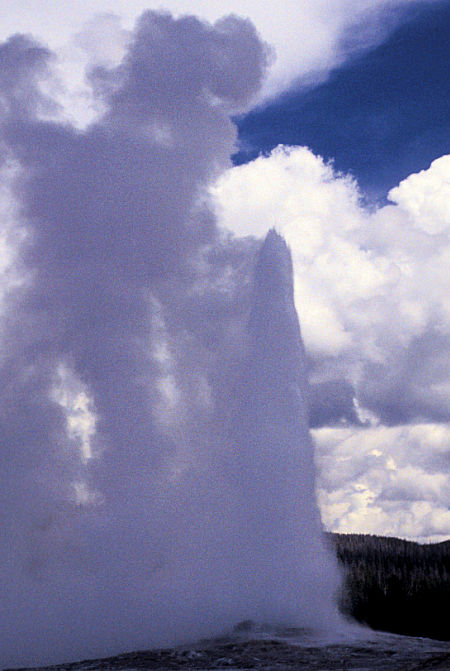
Old Faithful Geyser, Upper Geyser Basin, Yellowstone National Park
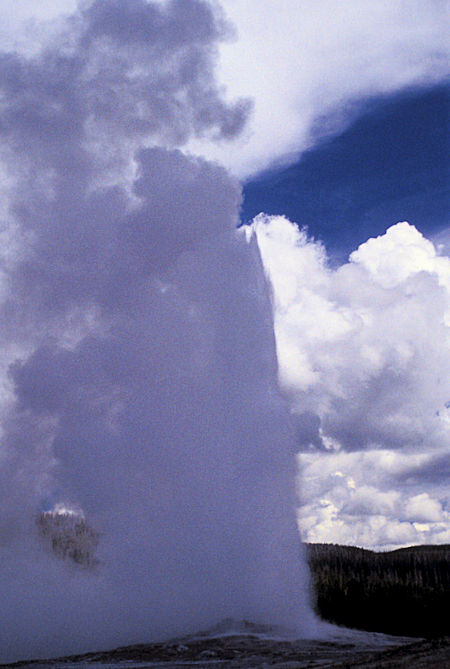
Old Faithful Geyser, Upper Geyser Basin, Yellowstone National Park
Daisy Geyser is the most reliable and predictable of the major geysers in the Upper Geyser Basin. Its average interval is between 85 to 100 minutes. However, wind and thunderstorms can delay an eruption up to a half hour.
Atmospheric pressure moves water within the underground plumbing system much as it does in a barometer. Splashing begins approximately 20 minutes before an eruption from the larger of the two cones, and 10 minutes before in the smaller cone. Heavy splashing leads to an eruption and reaches its maximum height in 45 to 60 seconds. The water jets at a 70° angle.
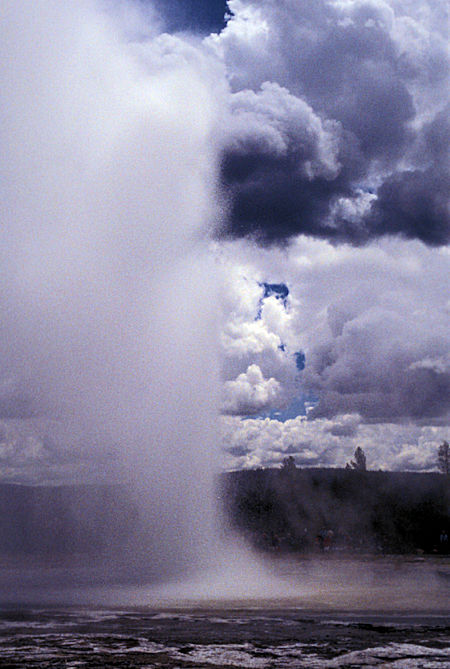
Daisy Geyser, Upper Geyser Basin, Yellowstone National Park
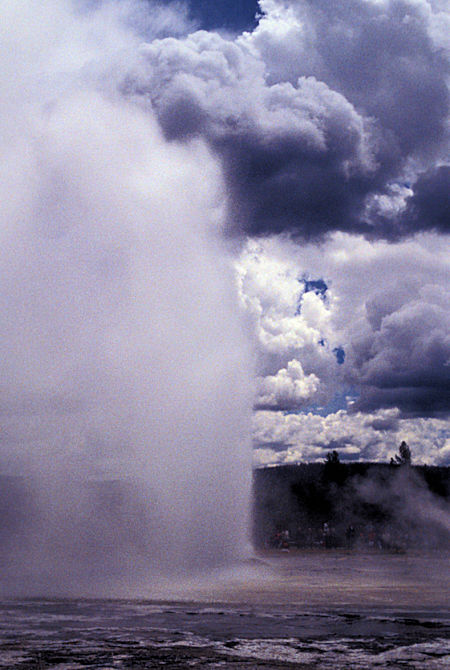
Daisy Geyser, Upper Geyser Basin, Yellowstone National Park
This fountain-type geyser erupts from a shallow basin which slowly fills with water over a 5 hour period. Two adjoining geysers, Turban and Vent, are separated by a thin narrow bridge. Grand's eruptive cycle depends on the activity of these two geysers and West Triplet and Rift geysers.
Grand only erupts at the start of a Turban active period. A slight ebb in Turban's eruption may signal an eruption of Grand with an explosion, pulsating vibration, and jets of water. During eruption Grand usually has 1 to 6 bursts lasting 1 to 10 minutes each.
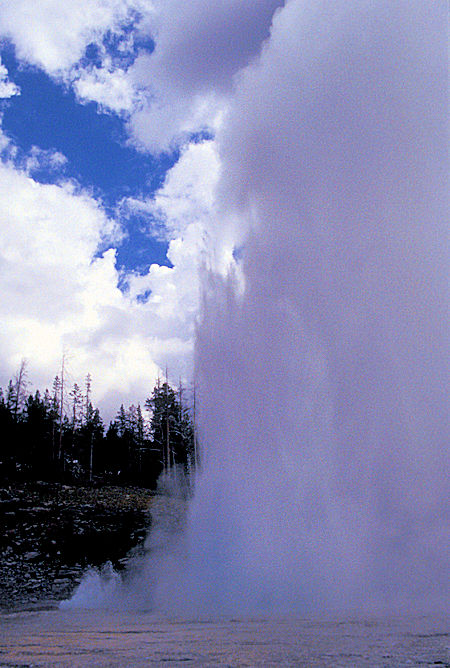
Grand Geyser, Upper Geyser Basin, Yellowstone National Park
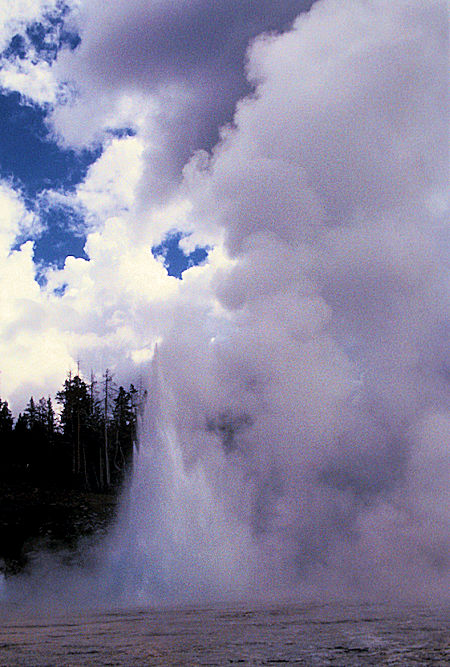
Grand Geyser, Upper Geyser Basin, Yellowstone National Park
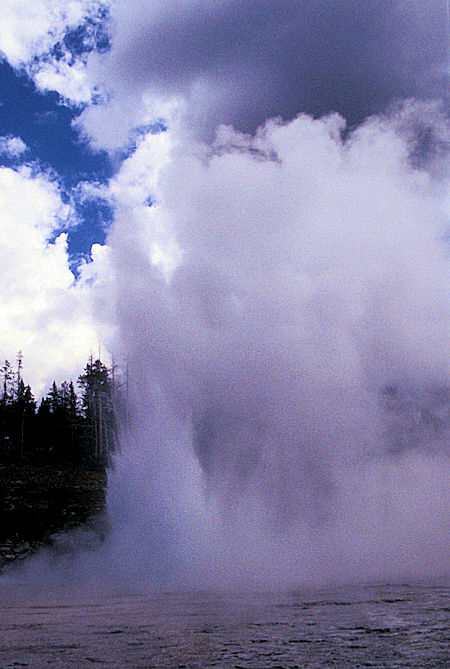
Grand Geyser, Upper Geyser Basin, Yellowstone National Park
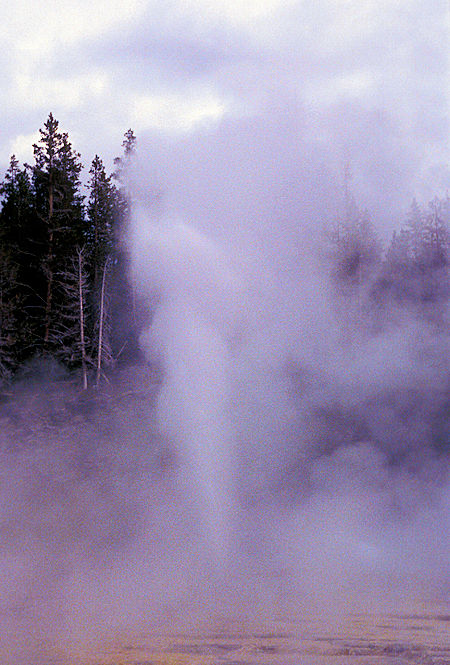
Grand Geyser, Upper Geyser Basin, Yellowstone National Park
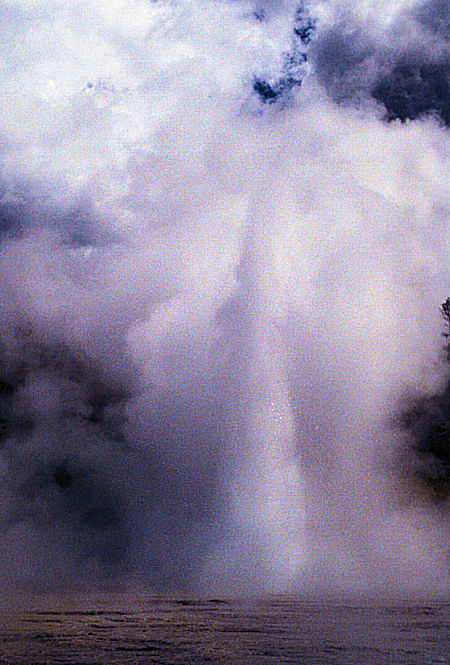
Grand Geyser, Upper Geyser Basin, Yellowstone National Park
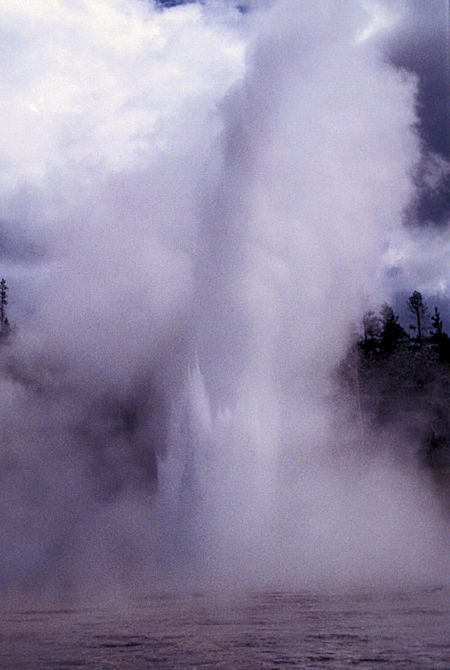
Grand Geyser, Upper Geyser Basin, Yellowstone National Park
The cone is three and a half feet high with a four foot diameter. Beehive, considered one of the largest active geysers in the world, erupts to a height of 200 feet. However, since its discovery, it has been unpredictable.
It has eruptive intervals of eight to twelve hours, but it has infrequent eruptions as long as 3 to 10 days and dormancy of weeks to months. A small vent located a few feet east of Beehive, called Beehive's Indicator, erupts 6-10 feet usually 10-20 minutes before an eruption.
An eruption begins with occasional splashing, then small surges. These progress into an eruption as the ground rumbles and a narrow, straight fountain of water jets upward.
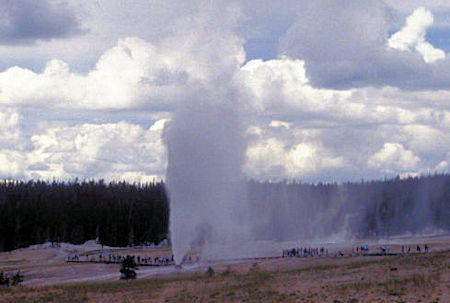
Beehive Geyser, Upper Geyser Basin, Yellowstone National Park
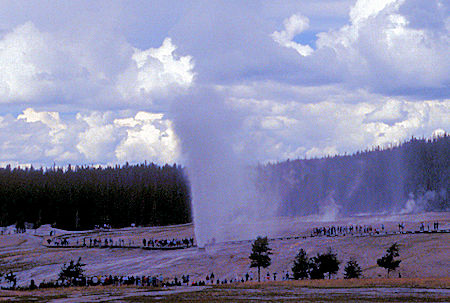
Beehive Geyser, Upper Geyser Basin, Yellowstone National Park
Chinaman has erupted 20-30 feet high, but all known eruptions were man-induced.
The first incident of a known eruption occurred in the 1880s when a Chinese laundryman pitched his tent over the spring and used the hot water as a clothes boiler. The clothes were suspended in the boiling water by a wicker basket. When laundry soap was added the spring erupted for the first time and a column of water ejected the laundry and collapsed the tent.
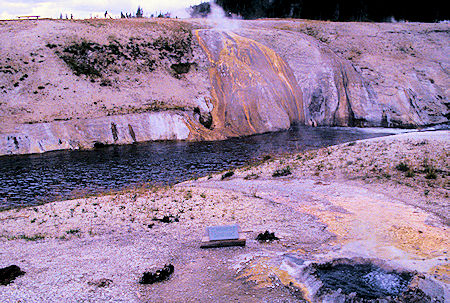
Chinese Spring (lower right), Upper Geyser Basin, Yellowstone National Park
This spring has had a history of vandalism. In 1946 during cleaning, a pile of debris three feet in height by six feet in width was collected. A bison calf fell into the pool in the mid 1980s and the bones can still be seen on the bottom. No known subterranean connection exists with other thermal features. The spring discharges approximately four gallons per minute.
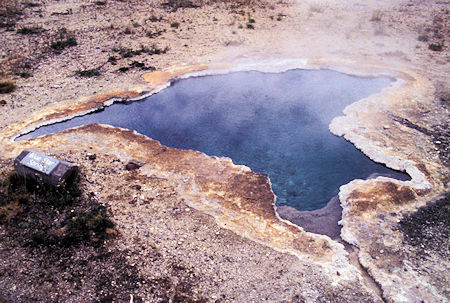
Blue Star Spring, Upper Geyser Basin, Yellowstone National Park
This spring is typical of many of Yellowstone's thermal springs. Nearly 10,000 thermal features exist in Yellowstone and many are alkaline hot springs similar to Heart Spring in size and appearance. One feature which distinguishes each is the bright, colorful cyanobacteria and algae which grow along the edge of run-off channels. Each spring has its unique pattern.
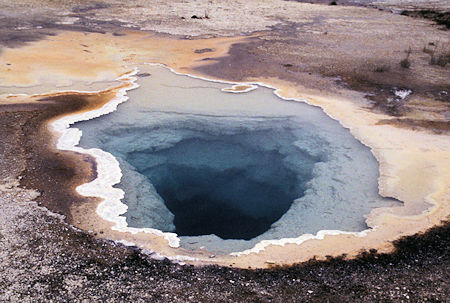
Heart Spring, Upper Geyser Basin, Yellowstone National Park
The spring was considered a geyser in the early 20th century but has not erupted for many decades.
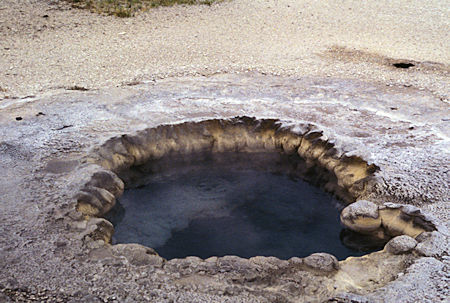
Beach Spring, Upper Geyser Basin, Yellowstone National Park
The pool produces a periodic, inaudible thumping which can be felt, more than heard, when standing close to the pool. The water also slightly pulses during the thumping process. It has erupted in the past, once during an eruption of a nearby geyser and after the 1959 earthquake. These eruptions were minor with boiling activity only two feet high. The overflow is small, discharging only one to 20 gallons per minute.
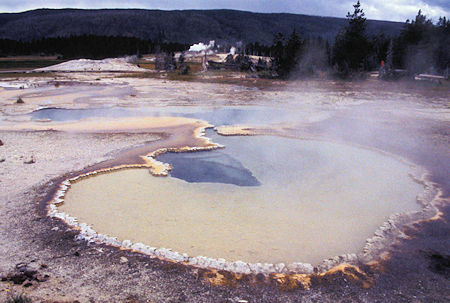
Doublet Pool, Upper Geyser Basin, Yellowstone National Park
Photographer W.H. Jackson took the first photograph of Crested Pool during the 1871 expedition. Other than the addition of a board walk, the pool has changed very little when compared to the early photograph.
It is a superheated pool and the edges are in a constant state of vibration with occasional surges of hot water. It has erupted to 6 to 8 feet. Temperatures recorded near the bottom of the pool have reached 237°F.
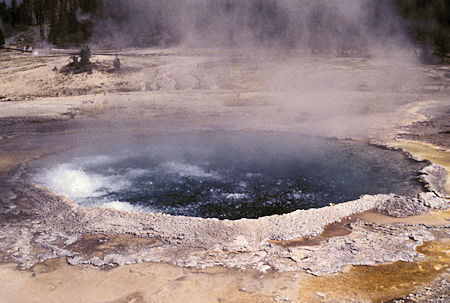
Crested Pool, Upper Geyser Basin, Yellowstone National Park
The crater of this fountain-type geyser is empty between eruptions. A gurgling sound and then a sudden filling of the basin indicates a pending eruption. Pulsating jets of water erupt through the pool producing a puffing or whistling noise. An eruption produces a large, steady discharge of water to the run-off channel. Subterranean connections exist between Sawmill, Tardy and Penta geysers and probably Spasmodic Geyser. Sawmill's vent has been probed to a depth of 13.5 feet.
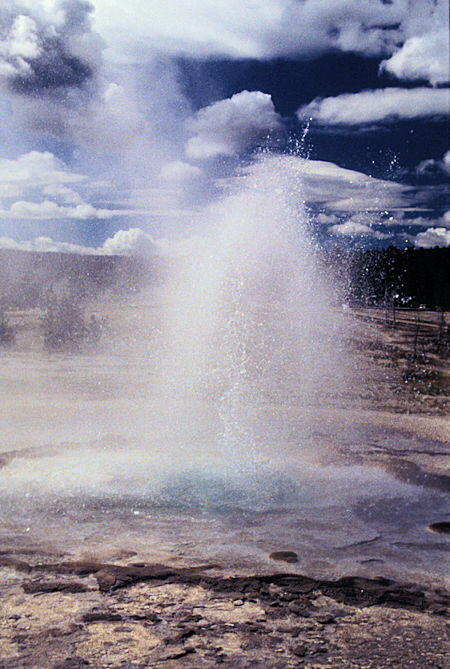
Sawmill Geyser, Upper Geyser Basin, Yellowstone National Park
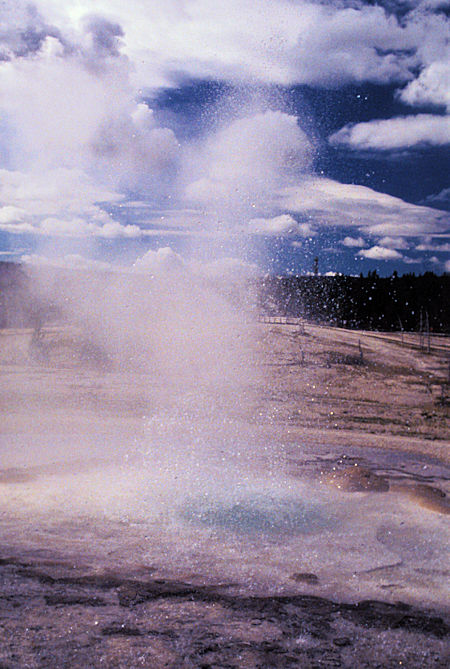
Sawmill Geyser, Upper Geyser Basin, Yellowstone National Park
The large sinter cone is nearly 12 feet high with a diameter of 20 feet at the top. Castle was an irregular geyser, with periods of dormancy, before the 1959 earthquake. Since the earthquake, it has been a regular, easily predictable geyser. The water phase of an eruption lasts about 15 minutes and a steam phase, similar to a steam locomotive, lasting an additional 45 minutes. Subterranean connections exist between Castle and Crested Pool.
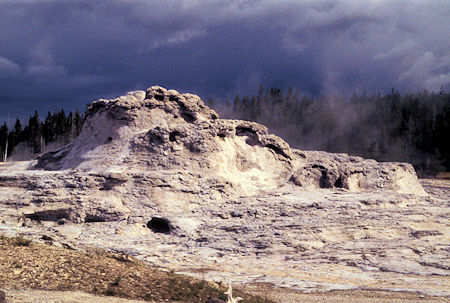
Castle Geyser, Upper Geyser Basin, Yellowstone National Park
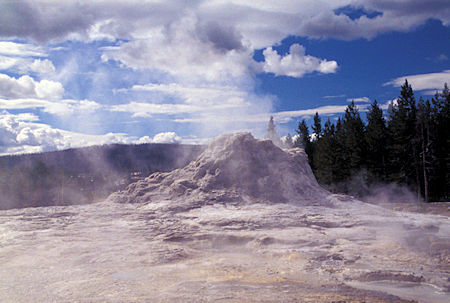
Castle Geyser, Upper Geyser Basin, Yellowstone National Park
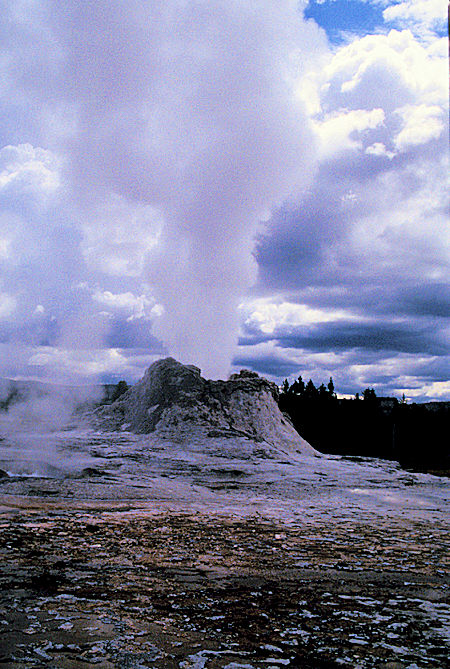
Castle Geyser, Upper Geyser Basin, Yellowstone National Park
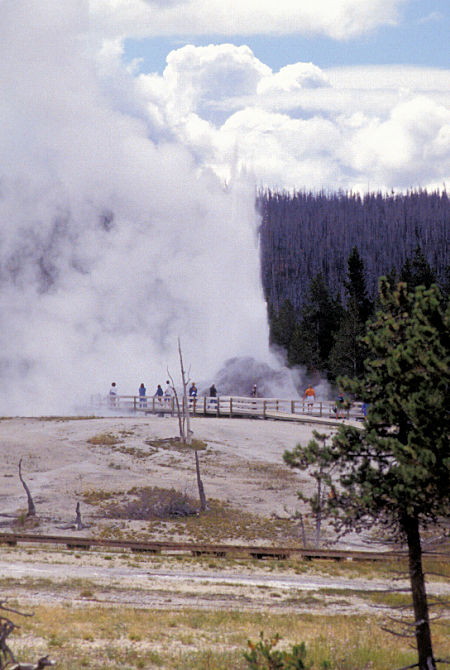
Castle Geyser, Upper Geyser Basin, Yellowstone National Park
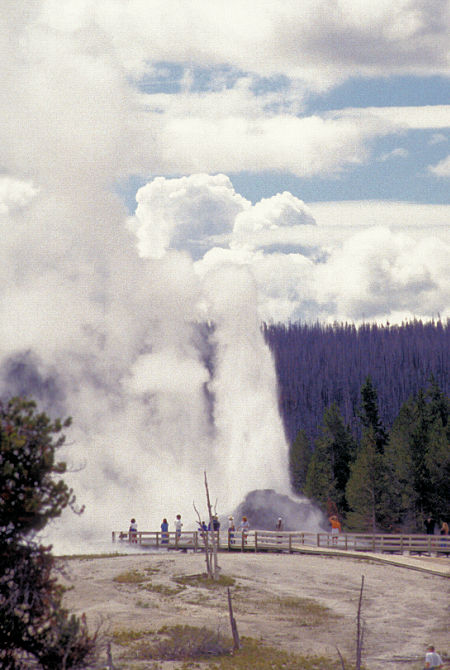
Castle Geyser, Upper Geyser Basin, Yellowstone National Park
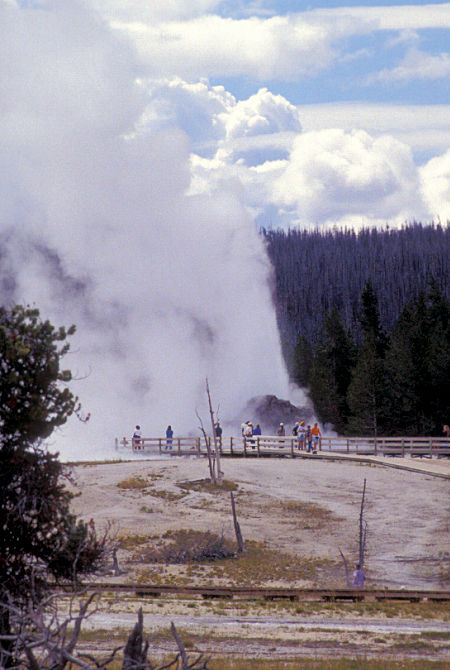
Castle Geyser, Upper Geyser Basin, Yellowstone National Park
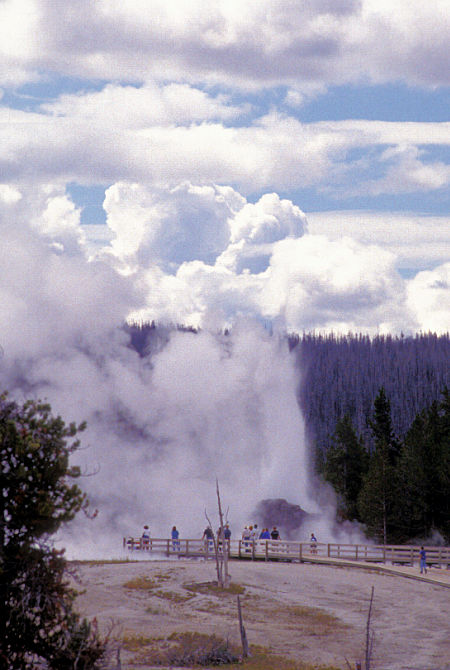
Castle Geyser, Upper Geyser Basin, Yellowstone National Park
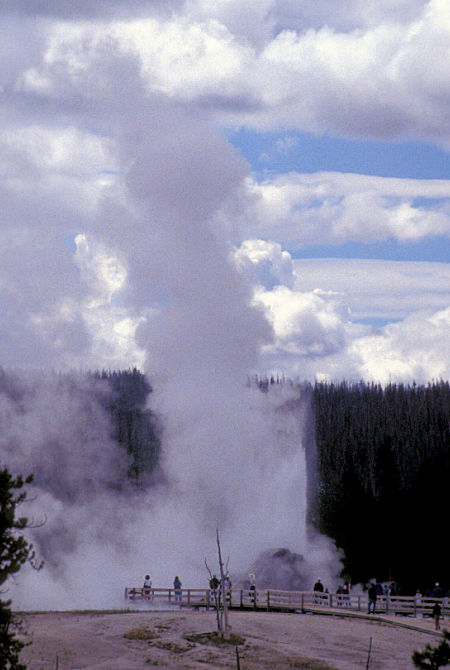
Castle Geyser, Upper Geyser Basin, Yellowstone National Park
This geyser plays from a collection of vents-estimated at 20-centered around two large craters.
When Spasmodic is in full eruption water jets from a few inches to several feet high from the numerous vents.
The two pools also erupt up to 15 feet high, with intermittent pauses and boiling, pulsating water.
Spasmodic and Penta geysers, and possibly Sawmill Geyser, have subterranean connections. When the small, nearby Penta Geyser erupts, all activity in Spasmodic ceases.
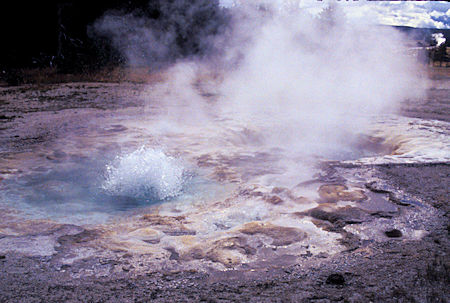
Spasmodic Geyser, Upper Geyser Basin, Yellowstone National Park
Lined with a thick coating of orage-brown cyanabacteria, its surface pulsates alightly, which, fortunately for the name, produces a constant train of tiny waves outward from the center of the spring.
Wave erupted a single time in late summer 1990. The eruption was not seen by reporting witnesses, but pieces of bacterial mat blown from the crater landed several feet away. The height may have been near 10 feet.
In early 2004, a small spring a few feet east of Wave underwent eruptions a few inches high. As small as that was, Wave's water level responded by dropping more than 6 inches, then recovered whenever the small geyser stopped playing.
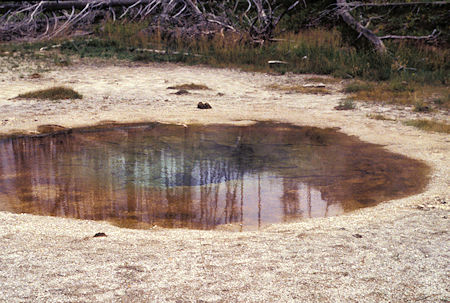
Wave Spring, Upper Geyser Basin, Yellowstone National Park
The two pools are related. When one pool begins to overflow, the water level in the other drops. This periodic shifting in energy is accompanied by a 10°F change in temperature. In recent years the water temperature has cooled, allowing an increase in bacteria and algae growth and a resulting change in color.
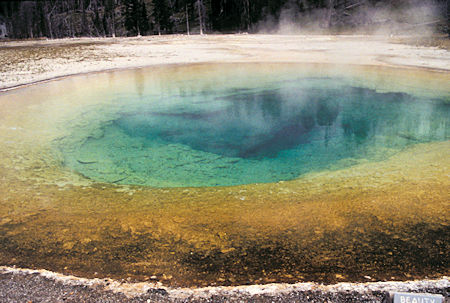
Beauty Pool, Upper Geyser Basin, Yellowstone National Park
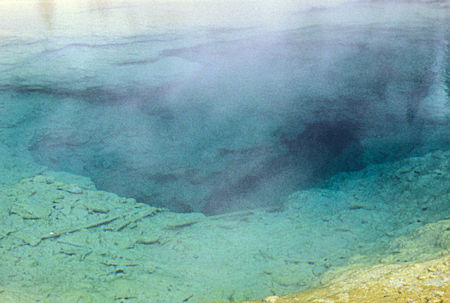
Beauty Pool, Upper Geyser Basin, Yellowstone National Park
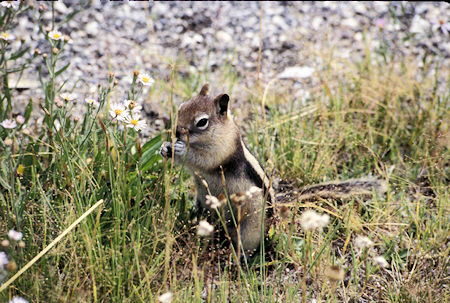
Chipmunk, Upper Geyser Basin, Yellowstone National Park
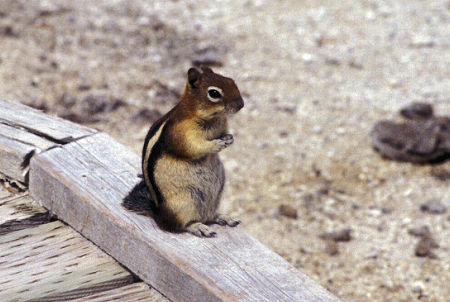
Chipmunk, Upper Geyser Basin, Yellowstone National Park

Marmots, Upper Geyser Basin, Yellowstone National Park
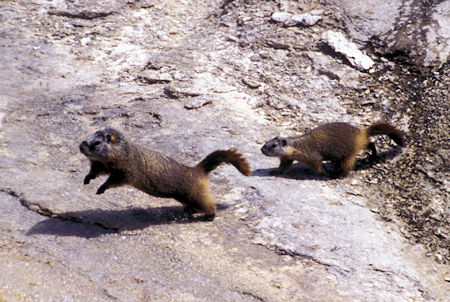
Marmots, Upper Geyser Basin, Yellowstone National Park
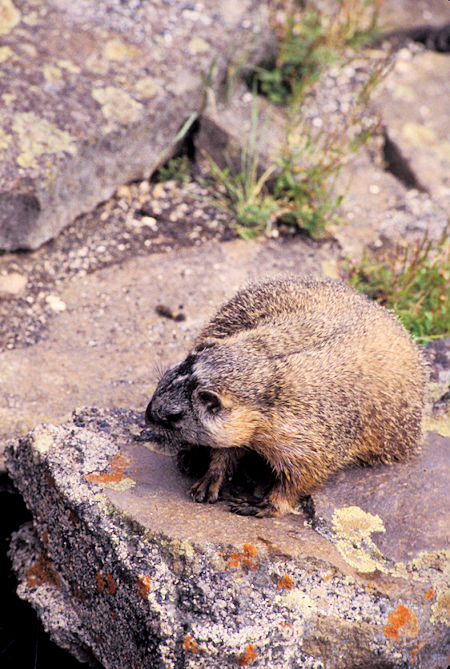
Marmot, Upper Geyser Basin, Yellowstone National Park
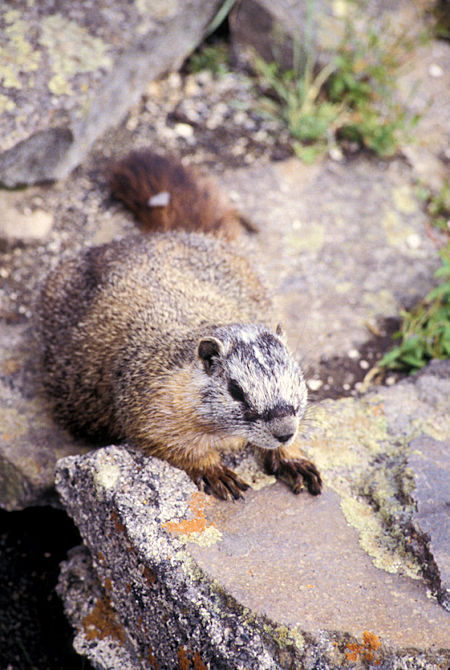
Marmot, Upper Geyser Basin, Yellowstone National Park
The club-shaped pillar and two adjoining arches formed from fallen trees. The accumulation of sinter from eruptions and evaporation has changed their original shape into eerie formations. The transfer of thermal energy from Giant Geyser to Grotto in 1955 has resulted in a productive feature. The eruptions consist of a series of powerful splashes, steam and the discharge of nearly 150 gallons per minute. Deep gurgling and splashing sounds are constantly emitted from the vent.
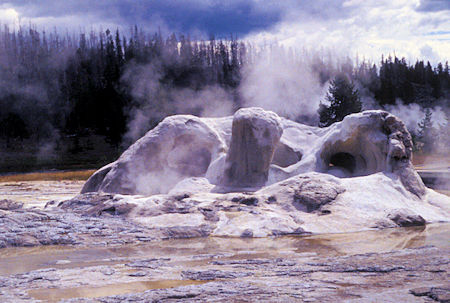
Grotto Geyser, Upper Geyser Basin, Yellowstone National Park
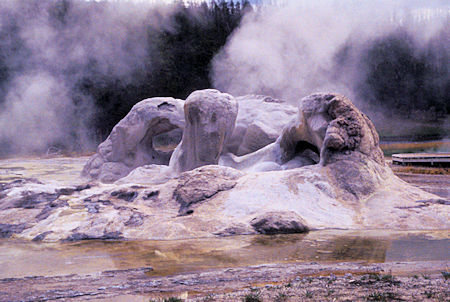
Grotto Geyser, Upper Geyser Basin, Yellowstone National Park
It has been a popular thermal feature and a symbol of Yellowstone. The early stagecoach and automobile road came within a few feet of this pool until 1971 when the road was rerouted. Early visitors carelessly removed the delicate scalloped border and dumped debris into the pool.
In 1950 the water level was lowered by siphoning which induced the pool to erupt. Socks, bath towels, 76 handkerchiefs, $86.27 in pennies, $8.10 in other coins came up; in all, 112 different objects were removed from Morning Glory. The debris had reduced the flow of water and contributed to the decline in temperature, causing bacteria to grow in the cooler yellow and orange edges of the pool.
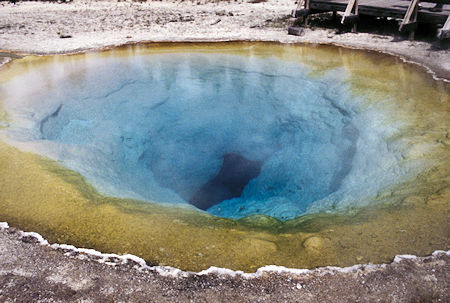
Morning Glory Pool, Upper Geyser Basin, Yellowstone National Park
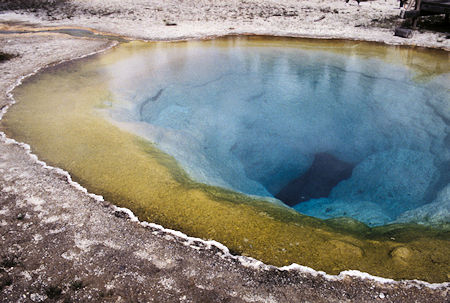
Morning Glory Pool, Upper Geyser Basin, Yellowstone National Park
It has only erupted several times since 1955. Before 1955 hydrothermal activity shifted cyclically from Grotto Geyser to Giant every four to five years, but since the 1959 earthquake, energy has vented through Grotto Geyser.
Giant still possesses great thermal energy. It roars, splashes, steams and has one of the hottest vents in the Basin. The cone is also impressive; broken on one side, it is 12 feet high, with an inside diameter of six feet.
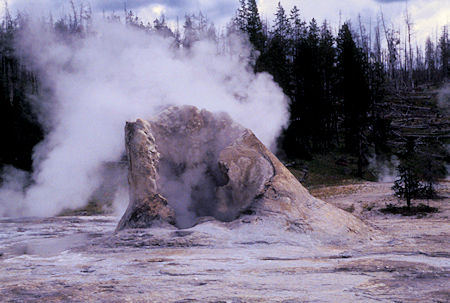
Giant Geyser, Upper Geyser Basin, Yellowstone National Park